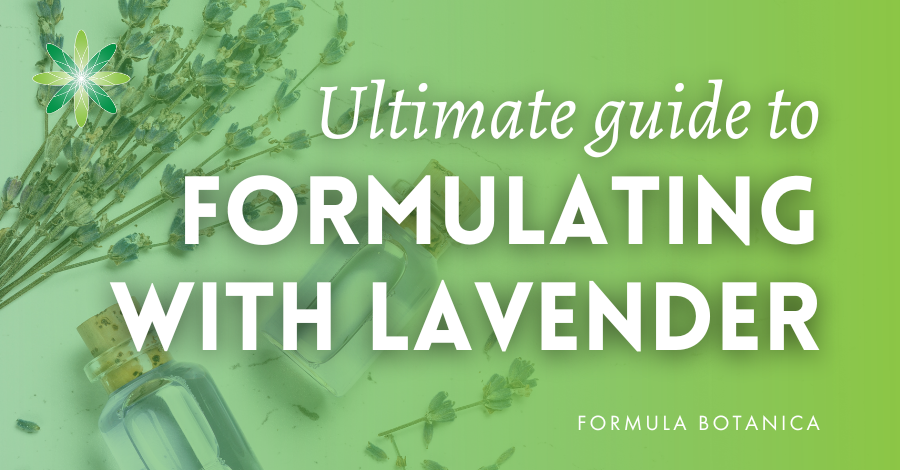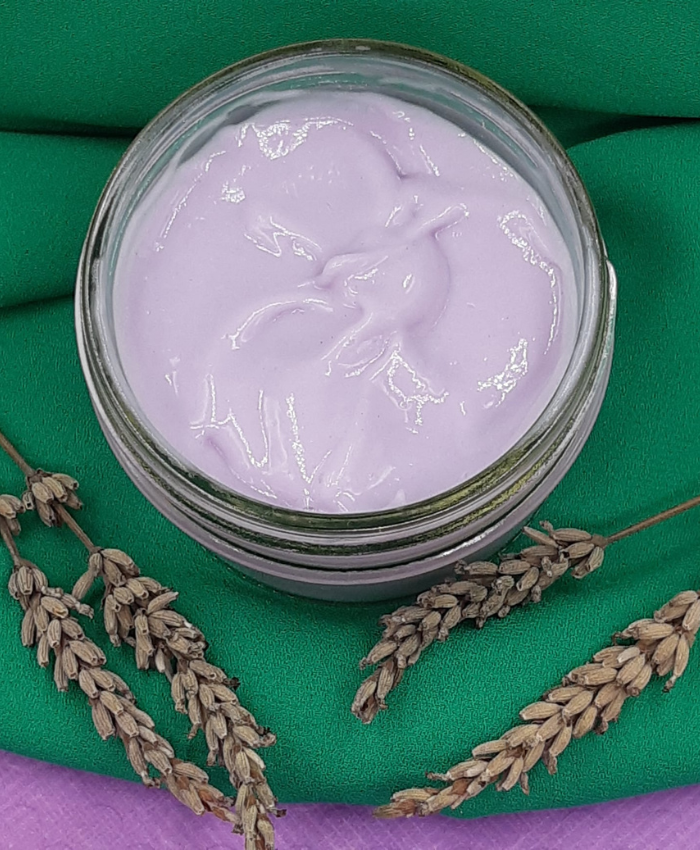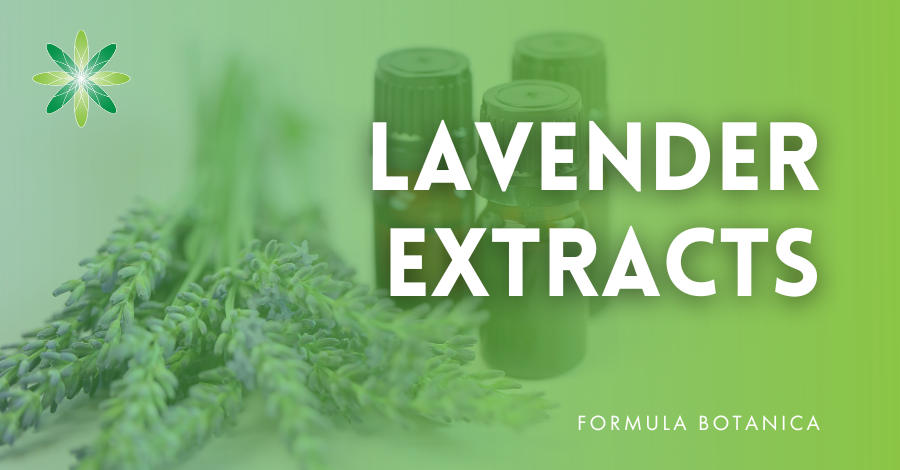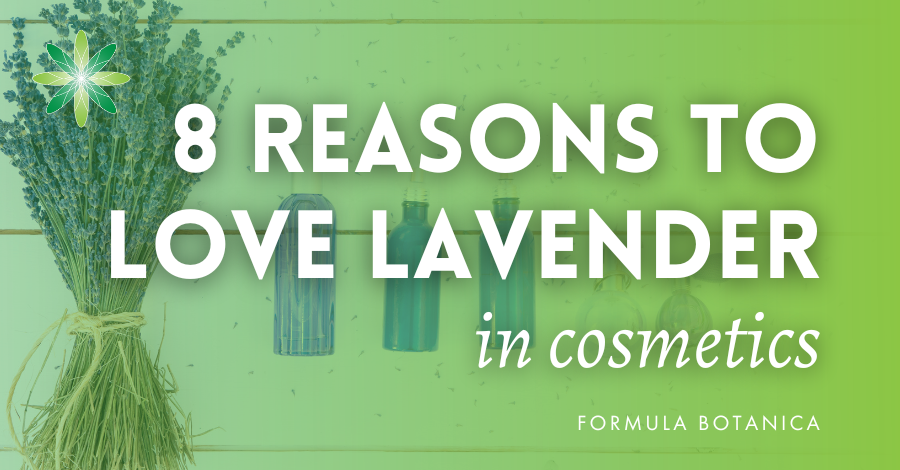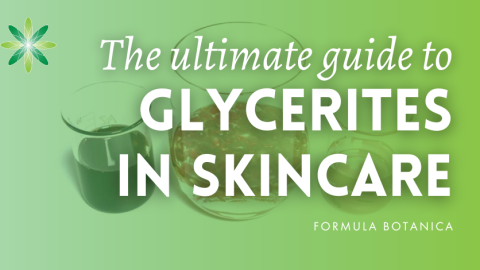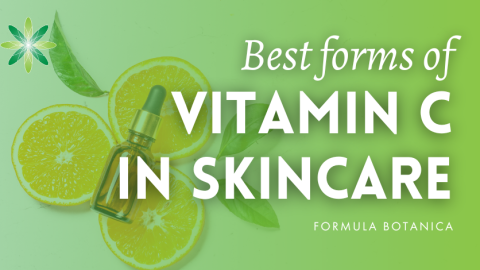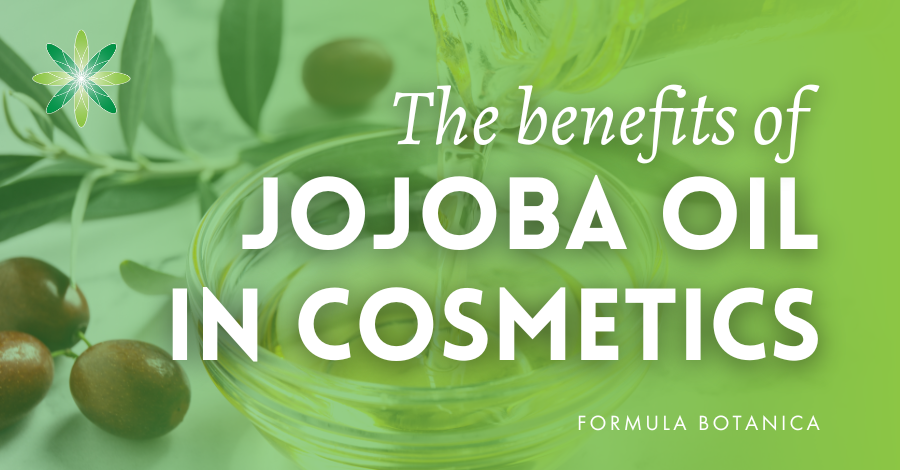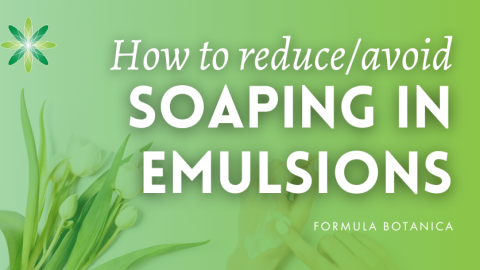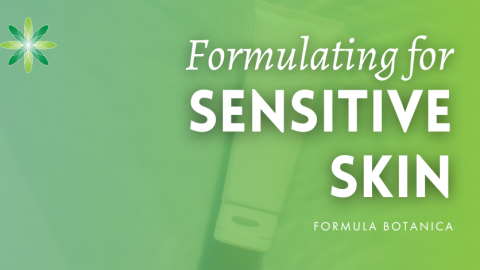When you start out formulating your own natural and organic cosmetics, lavender is likely one of the first botanical ingredients that you’ll reach for in one form or another – and for good reason. It is commonly available, has numerous cosmetic benefits, and is one of the most affordable ways to bring a natural floral aroma to your products. The scent is strong, so a little goes a long way, but it is generally liked and widely known as it features in everyday functional household products from soaps to detergents.
What is of interest to us as formulators is the fact that lavender is packed with research-backed benefits – it enhances skin radiance and clarifies, calms redness, soothes the psyche, has antimicrobial properties, and is of great benefit to mature skin.
Because it’s so common, it is easy to take lavender for granted or pass it over for more exotic botanicals. But this shrubby aromatic herb is bursting with goodness and keeps proving that it’s an indispensable ingredient for beginner and advanced formulators alike.
Formula Botanica graduate Pat Buckingham made this hand cream below with locally grown and distilled lavender hydrosol and gorgeous, nourishing botanical oils. She enhanced the colour with a little mica for the lavender hue. As you’ll find out later on in this post, there are so many extracts of lavender to experiment with in your formulations.
Just one true love of lavender in cosmetics
Among dozens of species, one is valued most for use in cosmetics: Lavendula angustifolia – also known as L. officinalis, English lavender, or “true” lavender. Lavandula hybrida, also called Lavandula x intermedia, is widely used as a cheaper alternative to the angustifolia variety.
Lavender is part of the Lamiaceae family – a huge group of flowering plants that includes rosemary, patchouli, mint, sage, oregano, lemon balm, and more. It is native to the Western Mediterranean, including France, Spain, and Italy, but is also grown in the United Kingdom, Bulgaria, Ukraine, Canada, USA, Australia, New Zealand, Japan, and more. However, France is regarded as the top-growing region, with the Maillette cultivar being the gold standard (i).
The word lavender comes from the Latin lavere, meaning ‘to wash.’ The Romans valued not only lavender’s fresh scent but also its antiseptic properties as well and used lavender flowers to perfume their public bathhouses (ii). There is evidence of lavender in cosmetics in ancient Egypt and of its use also as an embalming ingredient (iii), and if that’s not a convincing endorsement for lavender as an antioxidant, we do have the science now that confirms it (i).
What makes lavender so beneficial in cosmetics?
Two main monoterpenes are responsible for most of the cosmeceutical action of true lavender essential oil: linalyl acetate and linalool. These compounds, along with lavandulol and lavandulyl acetate, are what give the essential oil some of its antioxidant and antimicrobial properties, as well as its fine floral scent (iv), while the hydrosol is rich in antioxidant phenolic compounds. This is why Lavandula angustifola gets all the love – it’s more floral and higher in beneficial compounds compared with other varieties.
Lavandula stoechas, Lavandula latifolia (spike lavender), and Lavandula x intermedia – a hybrid of true lavender and spike lavender called lavandin – can also be used in cosmetics. These may contain some of the same benefits we find in the angustifolia variety, but in a lower amount, or, in some cases, not at all (Lavandula stoechas does not contain linalyl acetate). Plus, these varieties can have higher levels of camphor, 1,8 cineole, eucalyptol, and alpha-pinene, all of which are great for antimicrobial action but less desirable for scent (i). The safety data sheet (SDS) and certificate of analysis (COA) will often list the chemical constituents by percentage so you can compare varieties.
These higher-yield, lower-cost varieties are often used in soap, candles, and natural cleaning products where the benefits are not really needed, and the amount of essential oil required is a lot more than in skincare. But these lavenders can also be used to ‘extend’ the highly-prized and higher-priced true lavender (ii) – just one more reason to purchase from reputable suppliers.
Hungary-based Formula Botanica graduate Zita Gyurokovics (below) grows and distils lavender for her skincare brand Mar Galitti. She says that the idea for her brand was born when she bought 4,000 Lavandula angustifolia seedlings and was deciding what to do with this amazing, scented herb. Mar Gilliti skincare includes other herbs and flowers, but lavender is the brand’s love and mainstay, infusing many of the products in Zita’s range of cosmetics.
Lavender as a ‘new’ allergen?
The European Union is extending its list of fragrance allergens it requires to be indicated on cosmetic packaging if over certain percentages in a formulation. The list adds 56 allergens to the current 26 and will impact more natural ingredients – lavender essential oil and C02 extracts among them. This means that if lavender is in your product over a certain level, it must be declared on the label if it’s placed for sale.
Published in July 2023, the amendment (EU 2023/1545) to the cosmetic regulation will have a transition period before it comes into full force. We’ve got an interesting article on the background to this amendment explaining how it came about and how the cosmetics and fragrance industries influenced the outcome.
How to use lavender in your formulas
The following are the most common forms of lavender used for skincare and haircare. Lavender absolute exists, but due to its higher percentage of coumarin (an allergen that’s only permitted in small amounts), it is used mainly in natural perfumery and not recommended for skincare.
Essential Oil
INCI: Lavendula Angustfolia (Lavender) Oil
This is the volatile oil created by steam distillation of the flowers. It is a clear mobile oil and the most concentrated form of lavender extracts for cosmetic use, so it is the most effective way to bring the benefits of lavender to your formulas. It is oil-soluble, which means that you’ll have to use a solubiliser if you want to add it to a water-based product (an alternative to scent your product, if water-containing, is to opt for lavender hydrosol). We typically keep essential oils at 1% or under in a formula, but you need to calculate the total allergen load of all essential oils you use in a formulation to determine safe usage levels. These posts offer some background on using essential oils and CO2 extracts:
Why you should never measure essential oils in drops
Podcast episode 6: Essential oil safety with Robert Tisserand
Lavender CO2 Extract
INCI: Lavandula Angustifolia (Lavender) Flower Extract
The CO2 extract is like the essential oil in terms of benefits and oil-solubility but is extracted by carbon dioxide. This can result in a chemical profile that is slightly different from the essential oil. In fact, it’s been shown that the CO2 extract is higher in antioxidants (viii).
Lavender hydrosol
INCI: Lavandula Angustifolia (Lavender) Flower Water
Also called hydrolats, this is the water collected during the steam distillation of the essential oil. The hydrosol contains linalool, alpha-terpineol, borneol, and geraniol. Lavender hydrosol can be used up to 100% of your water phase. We have an article all about hydrosols, spotting so-called false hydrosols, and working with them in your formulations:
The formulator’s guide to hydrosols
Are you buying contaminated hydrosols?
Lavender macerated oil
INCI: Helianthus Annuus (seed) oil (and) Lavandula Angustifolia Extract (and) Tocopherol
This is created by the process of steeping, or macerating, lavender flowers in a plant oil (often sunflower) for several weeks to allow the non-volatile, oil-soluble components to infuse into the oil. The macerate is therefore far gentler on the skin and can be used at higher percentages than the essential oil and in a wider range of cosmetic product types. The INCI of lavender macerates will be different depending on the manufacturer and plant oil chosen. Lavender macerated oil can be used at up to 100%. For more information on macerates, see our posts:
How to make macerated oils
7 Steps to choose the right botanical oil for macerations
Lavender glycerite
INCI: Glycerin (and) Lavandula Angustifolia (lavender) Flower Extract
A glycerite involves a similar process to that of making an oil maceration but uses the solvent glycerine instead. Because glycerine is water-soluble, it is mainly only the water-loving or hydrophilic components of lavender that are extracted. The glycerite is added to the water phase of a formulation. Use a small amount – between 3-5% – since glycerites can feel tacky on the skin at higher percentages. We explain how to work with glycerine and make glycerites in our posts:
Reasons to love glycerine in your skincare formulations
The formulator’s guide to glycerites in skincare
Dried lavender flower buds and powder
INCI: Lavandula Angustifolia Flower / Lavandula Angustifolia Flower Powder
Whole and powdered lavender buds can add scent, colour, and visual interest to shampoo bars, bath oils, bath truffles, and more. The powder is perfect for dry masks and cleansing powders, and is used as an additive or active up to 10% on account of its strong aroma.
8 reasons to love lavender in natural cosmetic formulations
Let’s conclude with a quick round-up of our top reasons to love this versatile and skin-beneficial common and garden herb in our cosmetic formulations.
1. Skin radiance
It probably improves cell turnover (the natural cycle of cell renewal and desquamation) to give the skin a more radiant appearance. It also acts as a gentle exfoliant when the buds and powder are used as physical exfoliants.
2. Anti-inflammatory
Lavender in cosmetics has the proven ability to soothe skin inflamed by conditions such as eczema and psoriasis (v). When used in cosmetic formulas, it may help calm redness and irritation caused by blemishes.
3. Antioxidant
Terpenes, phenolic compounds, and flavonoids in lavender extracts are antioxidants that can help mitigate early signs of skin ageing. Find out more about how this works in our formulator’s guide to antioxidants in cosmetics.
4. Antibacterial and antifungal
Lavender is one of those magical unicorns that is gentle in its action even as it battles blemish-causing bacteria, yeasts, and other harmful microbes. It’s true that clove, oregano, and thyme are also antimicrobial warriors, but their potential for skin irritancy is much higher.
The gentler action of lavender could be due to its ability to ‘calm’ microbes and inhibit quorum sensing – that is, to block communication and prevent them from working together to cause a problem (vi). Lavender is one of the best oils for inhibiting quorum sensing (vii) and could be a good choice in products designed to respect the skin microbiome (ii). For more on our skin barrier function, see these podcasts and blog post:
Episode 161: Microbiome skincare – is this really a thing?
Episode 38: What is skin microbiome skincare?
Skin barrier 101: essental guide for natural cosmetic formulators
5. Calms body and mind
The relaxing and stress-relieving properties of lavender are well known, making it one of the best botanicals for bath products and nighttime treatments such as masks and hair oils.
6. Natural floral scent
Lavender has a high odour impact, so even a tiny amount can be effective at masking less-than-lovely ingredients (for instance, some preservatives in toners). From a perfumery point of view, it can bring a powdery (almost violet) aspect to floral blends, but it needs a light touch as it can quickly overwhelm.
7. Affordable
Compared to other florals such as rose, jasmine, and neroli essential oils, lavender is the cheap-and-cheerful of the bunch that doesn’t skimp on skin-loving benefits.
8. Easy to source
As touched on earlier, lavender is increasingly grown in many regions around the world and is available in one form or another, almost everywhere.
Next time you’re looking for a powerhouse cosmeceutical that’s more than just a pretty smell – plus, one that’s widely available and economical – remember your first love, lavender.
Further reading and references: lavender in cosmetics
(i) Miroslav Habán et al., 2023: Lavandula Species, Their Bioactive Phytochemicals, and Their Biosynthetic Regulation.
(ii) Marietta Białoń et al., 2019: Chemical Composition of Two Different Lavender Essential Oils and Their Effect on Facial Skin Microbiota.
(iii) Aromatic Plant Research Center, 2021: The History of Lavender.
(iv) Xiangyang Guo and Pu Wang, 2020: Aroma Characteristics of Lavender Extract and Essential Oil from Lavandula angustifolia Mill.
(v) Vineet Kumar Rai et al., 2020: Anti-Psoriatic Effect of Lavandula Angustifolia Essential Oil and Its Major Components Linalool and Linalyl Acetate.
(vi) Robert Tisserand: Resistance is Futile.
(vii) Mira Agnes Szabó et al., 2010: Inhibition of Quorum-Sensing Signals by Essential Oils.
(viii) Rebecca Wells et al., 2018: Lavandula Essential Oils: A Current Review of Applications in Medicinal, Food, and Cosmetic Industries of Lavender.
FREE TRAINING
Learn how to become an
Organic Skincare Formulator
FREE TRAINING
How to become an
Organic Skincare Entrepreneur
FREE TRAINING
How to become an
Organic Skincare Entrepreneur
Leave us a comment

Shauna is a former freelance writer at Formula Botanica. A former aesthetician, Shauna is also an active formulator and perfumer, and a member of the Formula Botanica community.

